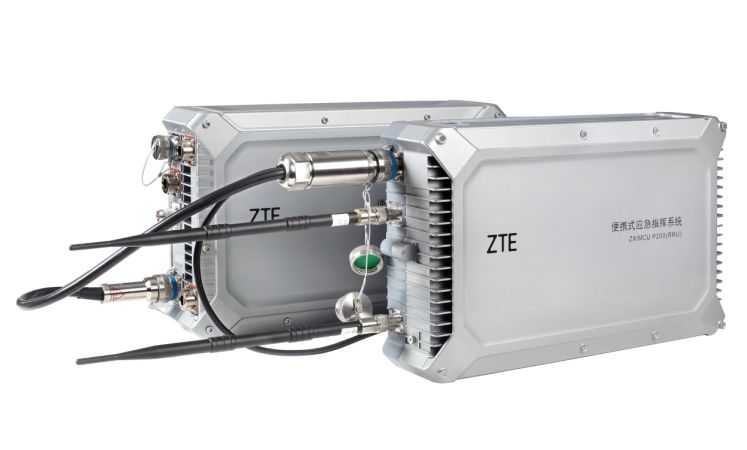When did Caltta first start to focus on narrowband-broadband convergence?
Caltta has deep insight into industrial trends. As early as 2014, based on our understanding of the critical communications market, we decided that our products should be based on the following principles: digital-analogue compatibility, broadband-narrowband convergence, public-private network integration, and support for advanced services. These principles are embodied in our "2+4" solution and a series of products. Our decision to pursue these principles has been vindicated by the widespread acceptance of the move toward convergence by users and vendors across the industry.
Could you tell us more about your "2+4" solution?
The full name of our “2+4” solution is 2G+4G Broadband and Narrowband Convergence Solution, which we launched at Critical Communications World 2014. Using converged networks, terminals and services, it perfectly integrates Digital Mobile Radio (DMR) with LTE. DMR provides seamless wide-area coverage in a cost-effective manner to guarantee voice services while LTE allows the use of critical data services and visualised dispatch services in key areas, to improve command efficiency and situational awareness.
Caltta’s DMR solution is based on DMR Tier III technology and uses industry-leading software-defined radio (SDR) architecture. With separated BBU (Baseband Unit) and RRU (Radio Remote Unit), the system is highly efficient and reliable. In addition, these systems and base stations can smoothly evolve into 4G systems, protecting customers' existing and future investments.
The 2+4 solution not only connects 2G and 4G networks, but provides PTT call, duplex voice call, messaging, location, data collection, information query, image and video transmission and other services in a single network through a unified system and hardware platform.
As one of the fastest growing vendors in the Chinese market, we have deployed "2+4" public safety network in more than twenty cities, including Beijing, Hefei, Xi'an, Wuhan, and Qinhuangdao etc. We are optimistic about its applications abroad. The “2+4” system can be interconnected with TETRA and P25 systems, fixed-line telephones, PSTNs, and SMSCs, via gateways and the universal SIP protocol, and is compatible with existing private network services.
How is Caltta looking to meet the demand for broadband-narrowband convergence?
We want to deliver an end-to-end convergence technology that fundamentally upgrades command and dispatch services. At the earliest stage, our focus was on developing broadband and narrowband converged networks. This is now mature as hybrid DMR-LTE networks have been deployed, using LTE base stations in key areas and DMR base stations for wide area coverage, with both types of base station controlled by a unified core network. We’ve therefore shifted our focus to the second and third stages: terminal convergence and service convergence. This year, we will launch a series of "2+4" convergence terminals, including "2+4" portable radio terminals and "2+4" mobile radio terminals.
Users of converged terminals will not unlock their full benefits without enriched converged services. These will require profound changes in individuals’ behaviour, operational procedures, and user skill requirements. We are now promoting service convergence for public security in two ways:
1. Upgrading from a traditional voice-centric commanding and dispatching system to a full media dispatching system for voice, video, and data convergence.
2. Upgrading from a traditional command and dispatch system based on unstructured data to a system based on both structured data and unstructured data. We will develop a new command and dispatch mode–Smart Command System, which will use image recognition, big data, artificial Intelligence (AI), and other technologies.
The core initiative behind the "2+4" solution is to build a Smart Commanding System through terminal convergence and service convergence.
Why do you promote the integration of public and private networks?
When it comes to radio access networks, it is difficult to meet the coverage requirements of a Smart Command System using only private networks, due to their high cost. It therefore makes sense to leverage existing public networks as much as possible. Private networks are reliable and public networks are complimentary in terms of coverage.
For instance, DMR is a general coverage technology that can cover a whole city through a few base stations. But how can we guarantee signal inside a building or an underground shopping mall? What about the blind spots inside a huge building? Obviously, the coverage of a private network is not as good as that of a public network. To solve this problem, we need to integrate public networks with private networks. For instance, we can connect a DMR network to a mobile police network through secure gateways in a city. In addition, we deploy platforms and applications that support both public and private networks. In an emergency, a dual-mode smartphone with an app (developed by Caltta) can be used as a walkie-talkie. Even in a blind spot with no DMR signals, the user remains connected with the commanding center as long as the handset has cellular connectivity.
To sum up, public networks are complimentary for private networks. We promote public-private network integration because it allows operators to make the most of their existing resources and through doing so expand private networks’ coverage and services.
Do you offer a PTT over cellular (PoC) solution to support your public-private integration strategy?
Yes, we are developing eChat wide area trunking solution based on 3GPP MCPTT architecture. This standard defines trunking capabilities that are comparable to those of a private network, defines the Quality of Service, and provides professional features that are not supported by a traditional PoC platform. It can remove customer doubts about their ability to communicate over traditional public networks during periods of extremely high load, through providing pre-emption and priority capabilities.
Mission-Critical Push to Talk (MCPTT) is a LTE standard, so eChat can be naturally integrated into a private LTE network. Meanwhile, eChat provides professional voice services and abundant data services such as image/video transmission, real-time video calls, and visual dispatching, allowing users to collaborate quickly and easily while in the field.
Unlike app-based VOIP solutions, we provide professional high-quality and high-reliability eChat terminals. Moreover, the eChat system is deployed in a distributed way and support load sharing and remote disaster recovery, thereby meeting industrial users’ requirements even in mission-critical scenarios.
Given the large number of PMR technologies in use today, do you offer unified dispatching systems that can work across more than one type of radio network?
Caltta has developed its 2+4 solution for private networks and eChat solution for public networks. To make these systems interoperable we provide our DAS ONE dispatch platform and NET ONE management platform.
DAS ONE is a comprehensive dispatch platform that supports the integration of voice, data, video, and positioning services. It can interwork through gateways with a variety of networks, such as TETRA, PDT, DMR, analogue trunking, eChat, PSTN, PLMN, and IMS. It allows unified dispatch of various types of terminals such as portable radios, mobile radios, and wireless cameras, meeting the requirements of multi-service integration, multi-system interconnection, and visualised dispatching.
Our platforms are designed to be open and to allow easy integration with third party applications. We’ve developed them in cooperation with upstream and downstream partners and we can customize them to better meet customers’ specific requirements. The platforms have been used in dozens of industries, such as police, transportation, firefighting, airport, port, petroleum, power, and railway industries.
What about terminals?
Caltta is one of the few vendors that capable of providing 2G/3G/4G terminals in the critical communications industry. We are committed to researching and developing high-quality digital trunking terminals. To meet different user requirements, we provide terminal portfolios covering LTE, GoTa (CDMA-based ITU Standard), DMR, PDT technologies, and eChat terminals based on operator networks.
This year, we will launch the GH880, a dual-mode (public and private) LTE portable radio, featuring advanced configurations, a big screen, an intuitive interface, reliable communication, high-quality sound and rich services. In addition, the GH880 is IP67 water/dust-proof, rugged enough to operate in demanding environment.
In the future, we will continue to make professional trunking terminals smarter and safer. Caltta will introduce a series of next-generation broadband-narrowband multimode trunking terminals with rich features and serves by the end of this year. We are constantly working to improve product quality across all our software, hardware, and application platforms; extend the scope of our product applications, and we are determined to create new value for our customers.
Are you planning to launch any other new products?
Caltta has launched the P200 Portable Emergency Command System based on its mature LTE technologies. This product can be used in harsh environments and quickly deployed in local emergency command networks – to the extent that it can be up and running in eight minutes. This product provides a series of emergency command and dispatch functions, such as audio/video trunking, video dispatch, GPS, data, and SMS. In addition, it provides data interfaces to interconnect with other systems.

It features:
1. High performance: high power, remote coverage, and high capacity (1,000 activated users)
2. Portability: modular, small, and light (10 kg per module)
3. High protection: IP67, dust-proof, and water-proof (1 m)
4. Adaptability: -40 °C to 60°C, 5000 m (altitude)
5. Robustness and shock absorption: It can be transported without any need for additional protection
The P200 has been used successfully in police, fire control, and earthquake rescue etc.
How is Caltta looking to increase its presence in overseas markets?
Caltta has won customers’ trust and cooperation with its continuous innovation, flexible customisation, and perfect delivery capability. Its products and solutions have been widely deployed in more than 40 countries, such as China, Nigeria, Senegal, Equatorial Guinea, Mauritius, Ghana, Poland, Czech, Chile, Haiti, Mongolia, Malaysia and Myanmar, and across 100 sectors, serving more than three million users for commercial use globally.
We lead the field in terms of private LTE as we hold more than 70 per cent market share in Chinese market and we are one of the key players in the global market. We recognise that it will take a long time for critical communications users to migrate from narrowband to broadband and we believe that convergence is the best solution during this transition because of its lower cost and its ability to allow smooth evolution as opposed to requiring users to change their networks and working practices overnight. We want to establish a global industrial chain of resellers and distributors to create win-win situations and maximise the commercial value created by our converged solutions.



+86-0755-86556659